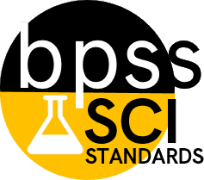SCI-MS.ESS2.06
SCI-MS.ESS2.06 Develop and use a model to describe how unequal heating and rotation of the Earth cause patterns of atmospheric and oceanic circulation that determine regional climates.Clarification Statement: Emphasis is on how patterns vary by latitude, altitude, and geographic land distribution. Emphasis of
atmospheric circulation is on the sunlight-driven latitudinal banding, the Coriolis effect, and resulting
prevailing winds; emphasis of ocean circulation is on the transfer of heat by the global ocean convection
cycle, which is constrained by the Coriolis effect and the outlines of continents. Examples of models can be
diagrams, maps and globes, or digital representations. Student Learning Targets:Knowledge Targets
Reasoning Targets
Skills (Performance) Targets
Product Targets
Proficiency ScaleThe Student can ...1 Beginning... with help, demonstrate a partial understanding of some of the simpler details and processes (Score 2.0 content) and some of the more complex ideas and processes (Score 3.0 content).
2 Developing... demonstrate no major errors or omissions regarding the simpler details and processes but exhibits major errors or omissions regarding the more complex ideas and processes (Score 3.0 content).
3 Proficient“The Standard.”... demonstrate no major errors or omissions regarding any of the information and processes that were end of instruction expectations.
4 Advanced... demonstrate in-depth inferences and applications regarding more complex material that go beyond end of instruction expectations.
ResourcesVocabulary
Websites
|
SCI-MS.ESS3
|
SCI-MS.ESS3.02
SCI-MS.ESS3.02 Analyze and interpret data on natural hazards to forecast future catastrophic events that necessitate the development of technologies to mitigate their effects.Clarification Statement: Emphasis is on how some natural hazards, such as volcanic eruptions and severe weather, are preceded by
phenomena that allow for reliable predictions, but others, such as earthquakes, occur suddenly and with no
notice, and thus are not yet predictable. Examples of natural hazards can be taken from interior processes
(such as earthquakes and volcanic eruptions), surface processes (such as mass wasting and tsunamis), or
severe weather events (such as hurricanes, tornadoes, and floods). Examples of data can include the locations,
magnitudes, and frequencies of the natural hazards. Examples of technologies can be global (such as satellite
systems to monitor hurricanes or forest fires) or local (such as building basements in tornado-prone regions or
reservoirs to mitigate droughts). Student Learning Targets:Knowledge Targets
Reasoning Targets
Skills (Performance) Targets
Product Targets
Proficiency ScaleThe Student can ...1 Beginning... with help, demonstrate a partial understanding of some of the simpler details and processes (Score 2.0 content) and some of the more complex ideas and processes (Score 3.0 content).
2 Developing... demonstrate no major errors or omissions regarding the simpler details and processes but exhibits major errors or omissions regarding the more complex ideas and processes (Score 3.0 content).
3 Proficient“The Standard.”... demonstrate no major errors or omissions regarding any of the information and processes that were end of instruction expectations.
4 Advanced... demonstrate in-depth inferences and applications regarding more complex material that go beyond end of instruction expectations.
ResourcesVocabulary
Websites
|
SCI-08.2Under Development
In the future this will contain narratives and other information about the Standard. | |
SCI-08.2.04
Student Learning Targets:Knowledge Targets
Reasoning Targets
Skills (Performance) Targets
Product Targets
Proficiency Scale
ResourcesWebsites Vocabulary | ||||||||||||||||||||||||||||||||||||||||
 DCI Earth Space Science ESS3
DCI Earth Space Science ESS3